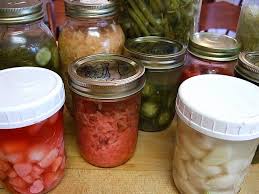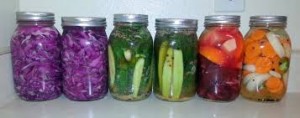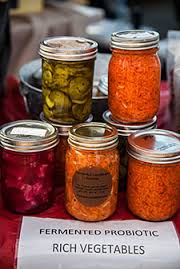 Unlock the True Potential of Vegetables
Unlock the True Potential of Vegetables
- By Kaare Melby
Organic Consumers Association, January 23, 2014 - Want to boost your immune system, increase the nutrient content in your food, improve your mental health and detox your body? Fermented vegetables are for you!Fermentation is the process that occurs when the natural bacteria in a vegetable break down the food’s complex elements into more digestible forms. When fermentation occurs, vegetables become easier to digest, allowing your body to work less, while reaping more benefits. And those benefits include higher levels of available nutrients, and live cultures of pro-biotic bacteria (kind of like the good stuff in yogurt). Fermented foods boost the amount of pro-biotics per serving. These pro-biotic bacteria can improve your digestion, boost your immune system, improve your mental health, and detox your body.
Worried that fermenting is risky? No need! Fermented veggies are actually safer than raw vegetables, because the fermentation process actually kills off any unwanted or dangerous bacteria that may exist on the food prior to fermentation. According to the USDA, there has “never been a single case of food poisoning reported from fermented vegetables.”
Fermented foods have been around for eons. Fermentation is an ancient art that pre-dates writing and agriculture. It’s often considered to be the practice that first ushered our ancient relatives from the natural world, into a culturally driven world. In fact, the word ‘culture’ is another word for fermentation. Sandor Katz, who has written several books on the subject, calls it “a health regimen, a gourmet art, a multicultural adventure, a form of activism, and a spiritual path, all rolled into one.”
And the good news is that it’s a simple process that even the most novice cook can accomplish.
To get started, you’ll want to choose vegetables that are fresh, local, and organic, as your ferment will be only as good as the ingredients you start with. You can ferment any vegetable, but some work better than others. It’s best if you experiment and find a mix of vegetables that you enjoy. Here at the OCA office, we like to mix as many fresh organic veggies together as possible. Not only does this create a variety of textures and flavors, but it also creates a wider variety of beneficial bacteria in the end product.
If you are looking for a good place to start, cabbage is easy to process, and makes a great ferment. Raddishes, carrots, turnips, apples and beets also make good ferments. The fermentation process creates a wonderful flavor that is often refered to as “sour.” But you can add more or different flavors in any way you want. Onions and garlic are great additions, and you can use fresh or dry herbs, and spices, too. The best approach is to experiment until you discover what combination of flavors you like most.
Here’s how to get started. 
What you need
• Fresh vegetables
• A knife or grater
• A glass or ceramic jar for fermentation (quart sized, wide-mouth canning jars work well)
• A smaller jar that fits inside the fermentation jar (small jelly jars work great)
• Salt
• Clean water
• A clean towel
• Rubber band to fit over the mouth of the fermentation jar
• Herbs and spices (optional)
What to do
• Chop/shred/grate vegetables, salting lightly as you go. You want to get all of the vegetables as uniform in size as possible. This way, they ferment at the same rate. Vegetables like carrots and radishes do well grated, while it’s best to slice up that cabbage or onion. As you chop or grate the vegetables, add small pinches of salt. But not too much—fermentation only needs a little. Try tasting as you go. The vegetables should taste only slightly salty.
• Mix the veggies well. You want to make sure that the salt is spread out evenly throughout all the vegetables. Taste the veggies, and add more salt to taste if needed. If you are going to add any herbs or spices, add them now.
• Let the vegetables sit for 5 to 10 minutes. As they sit the salt will start to draw the liquid out of the vegetables.
• Squeeze the vegetables to release their juices. Take handfuls of vegetables and squeeze as hard as you can, keeping the juice that comes out. You want to get as much juice out of them as possible.
• Tightly pack the vegetables into the fermenting jar and cover with collected juice. As you fill the jar with the vegetables, be sure to pack them down tightly to the bottom of the jar. This will help release more juice, and remove any air bubbles that get stuck in the vegetables. Add any remaining juice once the jar is filled. Be sure there is enough liquid to completely cover the vegetables. If you need to, use a mixture of salt and water to bring the juice level up over the vegetables. You don’t need too much salt for the water, just enough to make it taste like seawater.
• Fill the smaller jar with salt water, then place it on top of the vegetables in the fermenting jar. The purpose of the second jar is to hold the vegetables under the liquid in the jar. This will help the fermentation process by preventing “scum” from forming on the top of the ferment.
• Cover the fermenting jar with a clean towel, and secure it with the rubber band. Using a towel to cover the jar ensures that gases can escape, without letting any dirt or bugs get in.
• Let it ferment! Put the jar in an easily accessible area, and keep an eye on it. In about 24 hours you will begin to see air bubbles in the vegetables. This is how you know it’s working. After a few days, the ferment will start to smell sour. Taste it at every stage. This will help you determine how fermented you like your vegetables. Some people like “young” ferments that have only fermented a few days, while others like “mature” ferments that have been fermenting for months. If there is a white layer of “scum” that forms just scrape it off. It’s ok if you don’t get it all. When you like the flavor, remove the towel and smaller jar, put a lid on the fermentation jar and put it in your refrigerator. When the ferment cools down, the fermentation process rapidly slows, and you will be able to enjoy your fermented foods for several weeks or longer.
That’s it! Now you know the secret to unlocking the true potential of your vegetables. To learn more, check out Sandor Katz’s book “Wild Fermentation,” available through Chelsea Green Publishing. Good luck and happy fermenting!
Kaare Melby is social media coordinator for the Organic Consumers Association. 